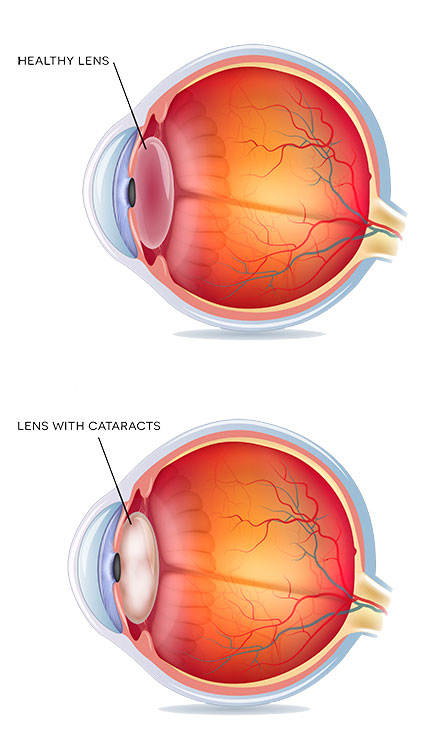Those suffering from cataracts experience a clouding of the natural lens inside the eye. The condition is very common and often inevitable as we age, with 60% of the population experiencing the visual complication as they reach their 60s.
What is a cataract?
Cataracts are a common visual problem. Often developing very gradually, the natural crystalline lens becomes clouded, causing vision to become misty. It is the most common cause of vision loss in the world. The word “cataract” comes from the Greek word “Cataracti” which means waterfall. The lens can take on this appearance when the condition is quite advanced.
The clouding of the natural lens of the eye affects us all as we age. Some of us develop this condition earlier than others but with all of us now living longer, unfortunately, this has become one of life’s inevitabilities.
Fortunately, it is treatable, and advances in cataract treatment mean that the problem can be treated very effectively with a simple and safe procedure.

What are the symptoms of cataracts?
The lens of each eye needs to be clear in order for your eyes to work properly, so cloudy lenses adversely affect your vision. In a normal eye, the clear lens allows light to reach the retina at the back of the eye, which then communicates with the brain via the optic nerve – this is how we see. However, with a cataract, less light can reach the retina, so your vision is affected.
The problem tends to develop slowly over time. Eventually, cataracts result in a gradual loss of the clarity of vision. Often, patients may complain of:
- Cloudiness or mistiness
- A fading or loss in the vibrancy of colour (although this tends to be a gradual symptom and less obvious)
- Increased light scatter, resulting in a dazzling “glare” when the eye is exposed to bright lights
- Changes to their glasses prescription
If you suffer from cataracts and would like to discuss potential treatment options, make an enquiry or call us on (02) 9452 6444.
What are the causes of cataracts?
As well as getting older, there are other factors that contribute to the likelihood of developing cataracts.
- Age - Because they develop gradually over time, cataracts are much more common in older people
- UV damage as a result of exposure to sunlight
- Familial factors: cataracts run in families, so if close relatives suffer from the symptoms then there will be an increased risk to yourself
- Steroid use
- Ocular inflammation
- Previous trauma
- Diabetes
What are the treatment options for cataracts?
The only way to treat cataracts is through the surgical removal of the cloudy protein within the natural lens. There is no way to reverse or “cure” a cataract.
Cataract surgery
Cataract surgery is a very successful treatment option and is the most commonly performed procedure in Australia. The surgery takes around 15 minutes, and is performed as a day case under local anaesthetic in most cases.
An ultrasound probe is used to gently break up and remove the cloudy natural lens, preparing the eye for an artificial lens to be inserted.
Read more about cataract surgery at Forest Eye Surgery
All surgical procedures carry some risk. The information provided here is for general educational purposes only. Please contact Forest Eye Surgery to find out if cataract surgery is appropriate for your individual situation.
For appointments and enquiries call (02) 9452 6444
Our rooms are open 8:30 am - 5:00 pm Monday to Friday
Unit 11, Building 7
49 Frenchs Forest Rd East
Frenchs Forest NSW 2086
info@foresteyesurgery.com.au
Phone: (02) 9452 6444
Fax: (02) 9452 6566
